Shares in the 7 key listed companies of the Adani Group have risen some 800% in the past three years. Now they’re falling and falling hard. So, why’s that? The trigger for the fall is the short selling report issued by Hindenburg Research. But there’s something we’ve got to know about short seller reports. They’re not, ever, the cause of stock prices falls. Because if they were then anyone could move stock prices by issuing a report and we know that’s just not true.

For a short report to succeed in moving the price it can only be the trigger for things that some to many already believed. At Adani Group there’s the obvious point that 800% share price rises don’t come along that often. Nor do they stay all that long when they do, on average. But there’s another thing. OK, so one line of business does really well. Say, coal during the invasion and the cutting off of Russian oil. Could be – and coal has done really well, and Adani is in the coal business. But all 7 listed companies doing that well? Hmm, no, seems a bit odd.
Maybe The Adani Group Is All Politics?
Could be that there’s a linking factor. Say, political connections in India and they are there. But we always do tend to think that political profits are a bit fragile – elections do happen after all. No one’s willing to call the next election yet but the Congress Party could do well.
Or, of course, it’s possible that certain games are being played with capital, debts, stock ownership and so on. Unacknowledged borrowing to buy shares in other group members – and vice versa – could explain the observed share price changes in the Adani Group – not to say that has happened, but it would explain observed share prices.
Hindenburg Could Just Be a Trigger for Adani Shares
If people are already thinking about such things, then a well-timed short seller report can be the trigger for substantial share price changes. Which is exactly what just happened. Most of the different share quotations of the Adani Group fell 20% the day after the report.

That’s just the background though. We, as traders, want to know what to do next. That’s something that will depend upon our beliefs about who is right here. Adani themselves have released a report they say refutes Hindenburg. It doesn’t, in fact, refute. It rejects firmly enough but there’s little detailed. “They say this and here’s why they’re wrong. And we’ve proven they’re wrong as well” which is what a refutation is. That’s not conclusive of course, for refuting a thousands of words long report in 24 hours isn’t an easy task.
Adani’s Defence Against Hindenburg Isn’t That Strong
Even within the report there are things we might not be happy with. As the FT says even as Adani says cross shareholdings are overstated, as are debt levels, there’s still a possible 17% of total shares outstanding overhang that’s at risk. Ouch.
There’s also the point that the Adani Group is issuing more stock. They’re – even on their own accounting – asset rich and cash poor. More cash is needed thus the share issue. The Hindenburg report has driven the share price down below the offer price of the new stock. That’ll make the underwriters unhappy and that generally does presage a softer share price in the future.
We can therefore take two different views here. Hindenburg is right, there’s something wrong here and we should expect Adani to unravel. We can also think that Hindenburg is wrong, Adani’s just fine – it’s politics not accounting driving the past share price rise for example – but given that share issue perhaps the Adani price will still be weak into the future. We’re in a go short or perhaps hold decision-place. Going long for the recovery looks unlikely on this analysis.
So, How Do We Trade Adani’s Problems?
But how, actually, should we try to trade this? Either way that is? Indian stocks are not hugely liquid outside India after all. It may well be possible to trade CFDs on some parts of the Adani empire but probably not on all. And a brokerage account in India to gain direct access seems a complication too far.
Nifty 50 And BSE Index – Adani’s Only in One Of Them
However, there’s one interesting little wrinkle here. There are two major Indian stock market indices. The Nifty 50 (INDEXNSE: NIFTY_50) and the Bombay Stock Exchange, BSE (BSE SENSEX). The Nifty 50 includes two Adani companies and yes, they are large enough parts of the index to move the whole. The BSE includes no Adani companies. The two indices are easy enough to find methods of trading. Quite apart from anything else they’re common enough CFD positions to be able to find.

So, the worse Adani does the more we’d expect to see the Nifty fall behind the BSE, other things being equal. And, of course, vice versa as well.
It’s Speculative but Possible to Trade Adani’s Problems
Now, whether we actually want to trade something like this on the far side of the world is another matter. And if we do we want to be sure that we’re trading with counterparties we understand. But that might well be the way to do it. Exploit the differences in the two index compositions to create and artificial exposure to Adani vs the rest of the market.
That then just leaving us with the decision of which way we think Adani is going to go – but that’s the difficult bit, isn’t it?